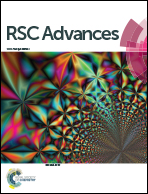Two Ln-based metal–organic frameworks based on the 5-(1H-1,2,4-triazol-1-yl)-1,3-benzenedicarboxylic acid ligand: syntheses, structures, and photocatalytic properties†
Abstract
Two new metal–organic frameworks (MOFs) having the formula [Ln2(H2O)3(L)3·3H2O]n (Ln = Sm for MOF-Sm and Tb for MOF-Tb) have been synthesized solvothermally by reacting LnCl3·6H2O with 5-(1H-1,2,4-triazol-1-yl)-1,3-benzenedicarboxylic acid (H2L) and characterized. Single crystal X-ray analyses for MOF-Sm and MOF-Tb revealed that both MOFs are isostructural and display a (6,8)-connected 3D structure with a point symbol of (35·44·66)(35·46·517). The natures of weak interactions existing in both MOFs have been assessed using Hirshfeld surface analyses and fingerprint plots. The utility of MOF-Sm as a photocatalyst for the safe photodegradation of the model aromatic dye methyl violet (MV) is also checked. The photocatalysis results showed that MOF-Sm offers reasonable photocatalytic degradation of this dye. The plausible photocatalytic mechanism of MOF-Sm aided photocatalysis has been explained with the help of band gap calculations using density of states (DOS) and partial DOS plots.



 Please wait while we load your content...
Please wait while we load your content...